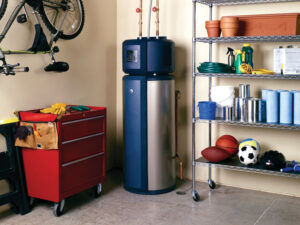By Thomas Kirk
 Water heating is the second largest use of energy in homes, accounting for approximately 14 to 18 percent of residential energy consumption. In addition to wrapping water heaters and pipes in insulation, there are many technologies in this market to help lower energy consumption and save consumers money. These technologies include heat pump water heaters (HPWH) and point-of-use (POU) water heaters.
Water heating is the second largest use of energy in homes, accounting for approximately 14 to 18 percent of residential energy consumption. In addition to wrapping water heaters and pipes in insulation, there are many technologies in this market to help lower energy consumption and save consumers money. These technologies include heat pump water heaters (HPWH) and point-of-use (POU) water heaters.
Heat pump water heaters
The heat pump water heater is not a new technology, but it is experiencing a revival. Some of the major manufacturers of water heaters and other appliances have entered the market, offering a new generation of heat pump water heaters.
There are two types. One, the more expensive option, replaces an existing electric water heater with a new, “integrated” unit combining a heat pump with a water tank. The second type adds a heat pump unit to an existing water heater. The heat pump in both versions circulates a refrigerant, which absorbs heat from the surrounding air and then passes through a compressor to maximize the heat output, which is transferred into the tank’s water. The heat pump can produce most of the heat needed by the water heater. A backup electric resistance element in the tank is called upon when the ambient air is too cold for heat pump operation or additional amounts of hot water are needed. Because the units use both heat pump technology and electric resistance for backup, the units are referred to as “hybrid” heat pump water heaters.
Heat pump water heaters use roughly half the electricity of a conventional electric water heater, but this efficiency comes with a higher price tag and potential trade-offs in effectiveness for participation in load control programs. Integrated units are selling for about twice the cost of a standard tank heater. Depending on the retail cost of electricity and the installed cost of the heat pump water heater, including any financial incentives, the payback period can be as little as three years.
A heat pump water heater can generally be installed in a conditioned or unconditioned space. However, the space must be at least 10 square feet to ensure adequate air exchange. An open basement, a utility area or—in some climates—a garage is appropriate. The cool exhaust air can be released into the area where it is located, cooling and dehumidifying the surrounding air, or it can be ducted outside.
Heat pump water heaters are most efficient in warm and damp climates. Homes in those climates will also benefit from the water heater’s cooling and dehumidifying features. However, residents in colder climates will see decreased performance during colder months. In the northern areas, for instance, if the heat pump is designed to work at ambient air temperatures of 45 degrees Fahrenheit or higher, the water heater’s electric element will operate whenever the air temperature drops below that level, reducing energy savings.
Point-of-use water heaters
Depending on where your water heater is located, you will lose some amount of heat as your hot water travels to the faucet. One technology to help reduce this loss is the point-of-use water heater (POU). These water heaters are located near to the water’s end use, for example, near the sink or shower. This option can be more efficient than raising the temperature of the main water heater. However, POUs cannot act as a back-up heater to intermittent units like solar or geothermal water heaters because they are not powerful enough to support a household’s entire water heating load.
Before purchasing a new water heater, be sure to check if any incentives are offered by your local electric cooperative for a particular type. Your co-op can also offer advice on which water heaters work well for your area, as well as other energy-saving tips.
Thomas Kirk is a technical research analyst specializing in energy efficiency and renewable energy for the Cooperative Research Network (CRN), a service of the Arlington, Va.-based National Rural Electric Cooperative Association.









